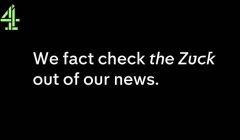
Channel 4’s fact checks the Zuck out of its news
The responsive campaign underlines the role of the news brand as a source of trusted news.

Are people empowered to take action or are they being paralysed with climate anxiety?

With sustainability calendar moments like Earth Day and Climate Action Week behind us, we are left with a familiar litany of individual actions: Go vegan. Never fly. Always buy second-hand. Switch your bank accounts and pensions. Recycle. Avoid plastic packaging.
These directives, though well-intentioned, can feel endless and overwhelming.
This feeling is often topped off with dread, waking to a barrage of news headlines warning of rising sea levels, soaring global temperatures and dwindling wildlife.
In this whirlwind of doom and gloom, I've started to wonder: is the current climate messaging landscape helping or hurting the cause? Are people empowered to take action, or are they just being paralysed with climate anxiety?
Are people empowered to take action, or are they just being paralysed with climate anxiety?
Charlotte Colombeau, Strategy Executive, Shape History

Fear-mongering dominates climate news, with headlines painting such a bleak picture, it makes me want to bury my head in the sand (or better yet, a compost pile). This fear-mongering can also erode trust in the media, as it is difficult to distinguish between what is factual and what is exaggerated to sell stories.
62% of emission cuts in the UK will need to come from behaviour changes, but when the media bombards us with warnings that we only have 6 years to stop the climate crisis, it’s difficult to believe that drinking out of a paper straw while it disintegrates into your lemonade is making much of a difference.
Emotion plays a key role in how we make decisions, which is why almost every piece of media or advertising attempts to incorporate it into its messaging. But not all emotions result in action - some emotions just fuel apathy.
So, what role do emotions play when it comes to climate messaging? Are these feelings of fear essential in motivating us to make these lifestyle changes, or are they having the opposite effect?
Let’s take a look…

Fear can be a double-edged sword. While it can motivate us to take action, too much of it can lead to apathy or even denial.
This excess of fear is what we call “Climate Doomism,” which holds that we’re past the point of being able to do anything about climate change and that humanity is highly likely to become extinct.
Climate scientist Michael Mann warns about the dangers of “overstating the science in a way that presents the problem as unsolvable”. The overwhelming dread instilled by this message can breed paralysis and disengagement. After all, if it truly is too late, why bother taking action at all?
However, studies show that fear doesn’t have to be all bad. In fact, a little fear can actually contribute to climate action: 90% of worried individuals made some or a lot of lifestyle changes, compared to 55% of relatively unworried people.
I can understand the appeal. Fear definitely motivates me to consider my carbon footprint and do my best to reduce it. However, it can be overwhelming, leaving me feeling helpless, and, at times, angry. But mostly, it leads me to want to disengage from reading about climate issues because the burden feels so heavy on individual action.

Good news doesn’t sell as well, meaning optimistic messaging is often sidelined in discussions about climate change - but it shouldn't be underestimated.
While a fluffy, sugarcoated narrative may remove the urgency of individual action, research suggests that positive messaging actually increases engagement and adherence to pro-environmental messages.
However, optimism needs guidance. Without guidance, inertia becomes a risk; 83% of people in Europe can’t identify what green behaviours they need to carry out.
People need to be encouraged to care with a clear understanding of what they must do.
Working on Climate Votes gave me the chance to really see the value of embedding actionable guidance into messaging. For example, rather than telling pension funds to stop investing in fossil fuels, we ran campaigns that explained how employees could take actions on an individual level to achieve this goal.
Climate change is undeniable, and action is essential. But do we need constant reminders of our impending doom? Some are advocating for a more balanced strategy, blending the sobering reality of climate change with a dash of optimism.
In addition to balancing fear and optimism, we need a roadmap to solutions.
So, if you, like me, are working in communications, consider the impact of your words. Are you inspiring hope and empowerment, or are you just adding to the noise?
The key lies in crafting a message that motivates action while also providing a glimmer of hope for the future—a message that acknowledges the challenges ahead but illuminates the path towards solutions.
In the face of climate uncertainty, let's strive for a narrative that inspires collective action and hope—one that empowers individuals to be part of the solution rather than succumbing to despair.
After all, it's through collective effort and unwavering determination that we’ll actually be able to fight this thing.
Charlotte is a Strategy Executive at Shape History with a proven track record in crafting and executing comprehensive communications strategies. With over three years of hands-on experience in the Fintech and International Development sectors, Charlotte has worked closely with organisations such as Save the Children and Barclays Bank. In her current role, Charlotte collaborates closely with influential partners, including WWF, Global Alliance for Improved Nutrition (GAIN) and Big Give.
Looks like you need to create a Creativebrief account to perform this action.
Create account Sign inLooks like you need to create a Creativebrief account to perform this action.
Create account Sign in